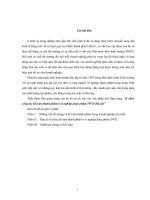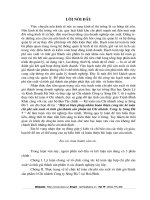7 ecommerce
Bạn đang xem bản rút gọn của tài liệu. Xem và tải ngay bản đầy đủ của tài liệu tại đây (944.67 KB, 39 trang )
Lecture 7: E-commerce, Web
2.0, and Social Networking
Systems
Study questions
Q1 How do organizations use ecommerce?
Q2 How do organizations use Web 2.0?
Q3 How Do Social Networks Add Value to
Businesses?
Q4 What are business applications for
Facebook, Twitter, and User-Generated
Content (UGC)?
Q5 How can organizations manage the
risks of social networking applications?
2
3
Q1 How do organizations
use e-commerce?
E-Commerce
e-commerce is the buying and selling
of goods and services over public and
private computer networks.
4
5
E-Commerce Company categories
Merchant: buy goods and resell them
Non merchant: sell services and goods
provided by others
a company can be both a merchant and
nonmerchant company.
5
6
E-Commerce Merchant Companies
Merchant companies:
1. B2C sales between a supplier and a retail customer
2. B2B sales between companies
3. B2G sales between companies and governmental
organizations
C2C
Source: textbook[1], page 250
7
Nonmerchant E-Commerce
Source: textbook[1], page 249
Auctions: match buyers and sellers by using an ecommerce version of a standard auction
Clearing house: provide goods and services at a
stated price and arrange for the delivery of the
goods, but they never take title.
Exchanges: matches buyers and sellers
7
Unique Features of E-commerce Technology
Ubiquity
Personalization
Interactivity
Information
density
eCommerce
techonology
features
Social
technology
Global reach
Universal
standards
Richness
8
Ubiquity
Internet/Web technology available
everywhere: work, home, and so on,
anytime.
Effects:
Marketplace removed from temporal,
geographic locations to become
“marketspace”
Enhanced customer convenience and
reduced shopping costs
9
Information density
Large increases in information density—
the total amount and quality of
information available to all market
participants
Effects:
Greater
price transparency
Greater
cost transparency
Enables
merchants to engage in price
discrimination
10
Global reach
The technology reaches across national
boundaries, around Earth
Effects:
Commerce
enabled across cultural and
national boundaries seamlessly and without
modification.
Marketspace
includes, potentially, billions
of consumers and millions of businesses
worldwide.
11
Universal standards
One set of technology standards:
Internet standards
Effects:
Disparate
computer systems easily
communicate with one another.
Lower
market entry costs; costs merchants
must pay to bring goods to market.
Lower
consumers’ search costs-effort
required to find suitable products.
12
Richness
Supports video, audio, and text
message
Effects:
Possible
to deliver rich messages with text,
audio, and video simultaneously to large
numbers of people.
Video,
audio, and text marketing messages
can be integrated into single marketing
message and consumer experience.
13
Social technology
The technology promotes user content
generation and social networking
Effect:
New
Internet social and business models
enable user content creation and
distribution, and support social networks.
14
Interactivity
The technology works through
interaction with the user
Effects:
Consumers
engaged in dialog that
dynamically adjusts experience to the
individual.
Consumer
becomes co-participant in
process of delivering goods to market.
15
Personalization/Customization
Technology permits modification of
messages, goods
Effects:
Personalized
messages can be sent to
individuals and groups.
Products
and services can be customized to
individual preferences
16
How Does E-Commerce Improve
Market Efficiency?
Disintermediate
Source: Vannevar
17
18
How Does E-Commerce Improve
Market Efficiency?
Price elasticity: measures the amount that
demand rises or falls with changes in price.
18
19
How Does E-Commerce Improve
Market Efficiency?
Price information:
Source: Digital River
19
20
Q2 How do organizations
use Web 2.0?
Web 2.0
focused on the ability for people to
collaborate and share information
online
21
Comparison of Web 2.0 with Traditional
Processing
Source: textbook[1], page 252
22
How Can Businesses Benefit from
Web 2.0?
Advertising
specific
to user interests
Example:
Google AdWords, Google AdSense
the
cost of reaching a particular, qualified
person is much smaller than in the
traditional advertising model.
Mashups
occur
when the output from two or more
Web sites is combined into a single user
experience.
Example:
Google’s My Maps
23
24
Q3 How Do Social Networks
Add Value to Businesses?
How Do Social Networks Add Value
to Businesses?
Increase the Number of relationships
Increase the Strength of Relationships
Progressive organizations:
Maintain a presence on Facebook, LinkedIn, Twitter,
and other SN sites.
Encourage customers and interested parties to leave
comments.
Risk - excessively critical feedback.
25









